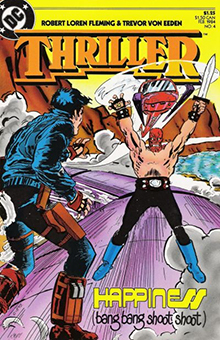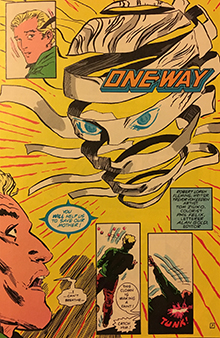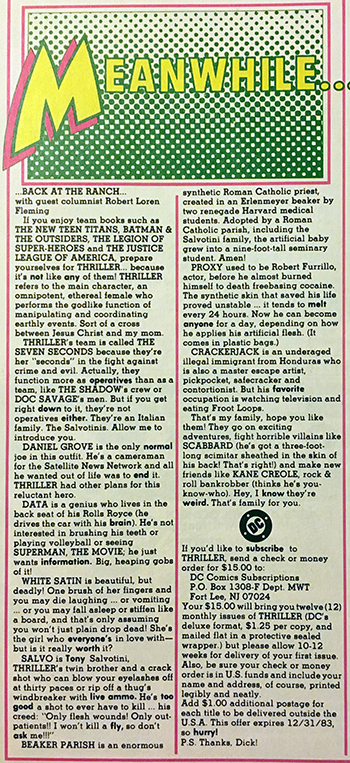Ed Catto: Thrill Ride with Robert Loren Fleming – Part 2
 This is the final part of my conversation with comics writer Robert Loren Fleming on the tragic backstory and forgotten history of DC’s Thriller comic book series. As I explained last week, this is actually an addendum to my recent article on this 80s cult favorite in TwoMorrow’s Back Issue Magazine.
This is the final part of my conversation with comics writer Robert Loren Fleming on the tragic backstory and forgotten history of DC’s Thriller comic book series. As I explained last week, this is actually an addendum to my recent article on this 80s cult favorite in TwoMorrow’s Back Issue Magazine.
Thriller was poised to be the next big thing from DC, but it seemed like many forces conspired against it. Despite it all, Thriller achieved a certain status. How did so many things go off the rails? The behind the scenes stories are as fascinating as the story between the covers.
Hazing, Publishing Style
There were some difficult things going on backstage at DC in those days. One of the uglier things was the hazing. It included everything from ripping up freelancers checks to harassing a female worker to the point where she was ready to clobber a co-worker on her way out.
 At the end of last week’s column, Thriller’s artist, Trevor Von Eeden had just finished the first Green Arrow mini-series. He was finally ready to start on Thriller. Management threw a curve ball and told him his next assignment would be a Batwoman special. However, Von Eeden firmly reminded them that the deal they had struck was he could start on Thriller once he finished the Green Arrow mini-series.
At the end of last week’s column, Thriller’s artist, Trevor Von Eeden had just finished the first Green Arrow mini-series. He was finally ready to start on Thriller. Management threw a curve ball and told him his next assignment would be a Batwoman special. However, Von Eeden firmly reminded them that the deal they had struck was he could start on Thriller once he finished the Green Arrow mini-series.
So for Thriller, Fleming would provide full scripts and write the dialog. Artist Von Eeden was given the authority to make changes in the scripts, but he seldom did.
Suspiciously enough, it went further than that. No editors had made any changes. “That’s not a good thing. That’s highly unusual,” remembers Fleming. That should have been a red warning light to the creative team back then. “They wanted to screw with us,” said Fleming. As the new kid on the block who had, in essence, jumped the line to land a prestigious job writing a comic he envisioned, Fleming had made many enemies within the organization.
Fleming would later learn that someone had taken the script from executive editor Dick Giordano’s office, and then made the case that it needed a total rewrite. “They were going to have me rewrite it until it wasn’t Thriller.”
 A few days before Fleming was supposed to start the rewrite, he was surprised to learn that Trevor Von Eeden had dropped off the all the pages of the first issue.
A few days before Fleming was supposed to start the rewrite, he was surprised to learn that Trevor Von Eeden had dropped off the all the pages of the first issue.
Plans for the rewrite were scrapped and Fleming was instructed to merely adjust the dialog to match the pages.
Now, years later, Fleming can understand the frustrations of the established folks at DC. It’s clear, as a young writer, he (Fleming) just wasn’t ready for a full writing assignment yet. At the same time, he also now realizes that the readers just weren’t ready for it then either. If it had come out five years later, it would have been much better received.
It wasn’t all bad at DC Comics. Fleming did have some supporters – specifically, the marketing department’s Mike Flynn and Roger Slifer. They were two of Fleming’s friends. They took a paste-up of the penciled pages, with Fleming’s hand-written word balloons, to use as part of a press release. Even though these pages were not properly lettered, public reaction to these pages was strong.
DC’s Marketing Department promoted it as a comic you couldn’t read fast enough, a line that Fleming had supplied. Soon, Fleming found himself on the convention circuit with a presentation, created by the Marketing Department, to tease the comic to retailers and fans nationwide.
Launching Thriller at that time through one of the major publishers was a blessing and curse. From our current vantage point, it’s difficult to remember that publishing a series like Thriller didn’t really have the many options that would be available today at Image or one of the smaller publishers.
Help Wanted
“I was keenly aware (back then) that it would have been great to get help <creating the comic>
But it was ‘do it on my own or not do it’,” said Fleming. He recalls that Dick Giordano was too far up the management chain, and stretched too thin, to be a hands-on helper for the title. Thriller’s editor, Alan Gold, was also new to the comics industry, having recently switched careers from editing medical textbooks. “He didn’t have a clue what we were doing.”
There was a little bit of light at the end of the tunnel. Fleming did manage to get in the good graces of legendary editor Julie Schwartz. “By the time I did a few Ambush Bug <issues>, Julie was in my camp. Most people would acknowledge Julie was probably the best editor at that time,” remembers Fleming.
Fleming is able to recognize the shortcomings of Thriller. “I have absolutely less affection for Thriller than the fans. I see it as a mess,” said Fleming. But he heaps praise on his collaborator, artist Trevor Von Eeden. “If we had had a routine artist, no one would be talking about this.”
A Thrilling Prescience
So many story elements of Thriller, a series created in the 80s that takes place in the “near future”, seem to have predicted actual future events. Fleming talked about how much of what he created for the book was simply an extrapolation from the headlines of the day. The long list is impressive and canny and includes things like America’s escalated conflict with Islam, self-driving cars, and the grisly filming of political decapitations.
On the other hand, Fleming admits that Thriller’s “black president was just a cheesy cliché” meant to signal the future. “Of course, I tied him to one of my characters,” he added.
Fleming touched on what could have happened. “Trevor and I never had a falling out,” said Fleming. “In fact, a few years later, we did a pilot for a Salvo series.” Salvo was the unflinching marksman, and one of Thriller’s Seven Seconds, in the original series.
“I was always trying to revisit Thriller,” admits Fleming. This would have been a prequel revealing the backstory of the marksman, Salvo. It would also detail how he first met Janet Valentine, (White Satin), and her husband Quo. “Quo was basically Bruce Lee,’” chuckles Fleming.
An earlier incarnation of the evil Scabbard – named Sheath Largos – featured prominently in the prequel. If the original Thriller series had continued, Scabbard was slated to return from the dead. “He was War of the Worlds in reverse,” reveals Fleming. “Scabbard was actually a mechanical alien in the shape of a sword who grew a fleshy body around itself simply for transportation.”
“That’s why we did Scabbard in Ambush Bug,” said Fleming. “You see something bursting out. It’s flesh growing. Keith (Giffen, his collaborator on Ambush Bug) knew what I was going to do.”
The Thrill is Gone, Baby
Fleming admits that it would unlikely he’d ever return to the series.
“One reason is because it was science fiction, it makes it hard to contemplate going back. “Things have changed so much. The thing about science fiction is that it reflects what’s happening when it’s being written,” explained Fleming.
But there’s a lot of lessons he takes away from it all.
First and foremost is that not knowing the rules is a good thing. The exuberance of youth actually allowed Fleming and Von Eeden to courageously create a series that, in retrospect, is astounding that it even exists. “Thriller was world-building before it was in vogue for comics,” said Fleming.
There’s a sense of pride but also a sense of generous humility. “The best thing about it was Trevor’s artwork,” remembers Fleming. “His artwork took it to a new level.” Fleming also explained how he meets many fans who explain that this groundbreaking series inspired them to break into the industry.
“The reason for going into this – the generally accepted wisdom was that Thriller was a big failure,” reflects Fleming. “It wasn’t a failure. Thriller was created so I could become a writer. In that way, it was a success. I did become a writer… from zero to sixty. I became a comic book writer.”
And that sounds like a thrill to me.
Interested in the full article in Back Issue #98? You can snag it here.












